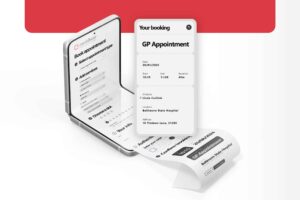Unseen, unmeasured and unforgiving, inefficiency is bleeding your practice dry.
You might never see the moment the leak starts, but every day it widens, siphoning hours, morale and money without warning. If you have ever found your team exhausted by admin and paperwork, wondered why patients vanish before they check in or felt the sting of billing errors, those frustrations are not routine. They are profit leaks that demand action.
The Iceberg You Can’t Afford to Overlook
Imagine your clinic’s expenses as an iceberg. Above the surface you see the familiar costs: software licence fees, rent, staff salaries. Those are the line items you track on your monthly budget. But beneath the surface lies a much larger, unseen mass: duplicated data entry, late appointment reminders, manual invoice matching and fragmented systems. Those hidden inefficiencies chip away at your margin every day.
And the numbers tell the real story:
- Primary care physicians spend 36.2 minutes per patient visit interacting with their EHR. That includes 6.2 minutes of after-hours “pajama time” and 7.8 minutes in the inbox.
- Nearly 18 percent of patient records in U.S. hospitals are duplicates, driving over $6 billion system-wide costs, roughly $1.5 million per hospital each year.
- Even with reminders, 5–7 percent of appointments still end in no-shows, amounting to an estimated $150 billion in lost revenue annually.
Stack those figures together and you get a snowball effect of time, money and morale drain, often without you even noticing. In fact, our analysis shows a ten-clinician practice can forfeit over £2.3 million in hidden costs over just one year. That’s funding you could channel into new services, upgraded equipment or staff development, yet it is lost beneath the surface.
Why “It’s Just the Way Things Are” Is a Costly Trap
Far too many practices shrug and accept admin overload, no-shows and manual rework as unavoidable. You hire extra staff to chase forms. You push back billing deadlines to allow for error correction. You resign yourself to appointment gaps. That shrug says inefficiency is normal. In truth, it is a self-perpetuating drain on your resources.
Consider this: every repeated entry, every misfiled referral and every phone tag with insurance carriers tells your team that their time does not matter. Clinicians spend more time clicking than consulting. Administrators spend hours chasing data instead of supporting patients. That costs far more in staff burnout and turnover than any hire you could make.
To understand the scope of hidden costs, let’s break down a typical appointment cycle:
- Booking and Confirmation
A patient calls or emails to book an appointment. Your front-desk team toggles between two or three systems; one for scheduling, another for reminders, then sends a confirmation manually. Five minutes quickly go by. - Check-In and Documentation
On arrival, the patient fills out a paper form. After the consultation, a staff member types that information into the EHR. Between scanning, transcription and correcting typos, you lose ten to fifteen minutes per visit. - Billing and Claims
Once clinicians close out their notes, a staff member must export billing codes into a separate invoicing tool. A single mistyped digit can trigger a denial or delay, and even if the error is caught, correcting it adds at least five more minutes of work. If the mistake slips through though, the claim can enter a lengthy appeals process. Industry data show providers endure an average of three review cycles with insurers, each lasting 45–60 days, before payment. That means weeks, sometimes months, of delayed revenue and extra administrative burden..
When you accept these inefficiencies as “just how it goes,” you permit your practice to bleed time, money and morale, often without ever noticing. Instead of focusing on patient care or strategic growth, your team is mired in repetitive, low-value tasks. It’s a costly trap that only deepens until you choose to plug the leaks.
Turning Frustration into Opportunity
What if the tools you already have could transform bottlenecks into breakthroughs? A unified, cloud-based platform can eliminate the repetitive steps that drain hours from each day.
Picture a system where appointment reminders send themselves, freeing your front desk from juggling calendars and messaging apps. Patient information flows straight into the EHR, removing the need for scanning, retyping and fixing errors. When clinicians finish notes, billing codes transfer instantly to invoicing, reducing claim denials and shortening appeal timelines. Technology stops feeling like a cost and becomes a way to reclaim time and protect revenue.
These improvements show up in real numbers. Clinics that adopt streamlined workflows often see no-show rates fall and administrative time cut in half. Staff members feel empowered instead of overwhelmed, since they no longer spend hours correcting mistakes or hunting down missing information. However, many people believe that clicking “go live” on a new digital tool counts as digital transformation, when in reality simply tacking on a platform without rethinking workflows creates confusion and chaos. Real change comes from redesigning daily processes so your practice can grow sustainably.
A Clinic That Refused to Lose
Pure Sports Medicine proves that scaling to multiple locations does not require a ballooning administrative team or tangled workflows. They rolled out new sites one after another with a centralised management system that kept every process consistent. Patient check-ins, appointment scheduling and billing followed the same clear steps whether a client walked into Site A or Site F. That consistency meant staff never had to relearn procedures or chase down missing information. Instead of lengthy back-and-forth conversations about which form to use or how to code a claim, Pure Sports Medicine’s team simply followed a proven playbook. As patient volume grew, their admin workload stayed flat, and their brand stayed strong because every clinic operated the same way.
This level of control and clarity could be your future. Maybe you’re eyeing a second, third or fifth location but worry that your current workflows will buckle under the weight. Or perhaps you run a single clinic where messy processes lead to staff frustrations, patient complaints or small inefficiencies that never seem urgent, yet still chip away at your revenue. Or maybe everything seems “normal,” but you’re curious how you could improve even more. If any of these sound like you, we’ve got the perfect next step.
Listen to Meddbase and Pure Sports Medicine as they reveal exactly how simplified,centralised workflows make scaling easy and protect your revenue. Hear real-life examples and leave with strategies to uncover hidden gaps and plug those profit leaks. Listen now here.





